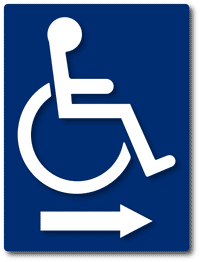
Wayfinding ADA Signs
ADA Guide, Wayfinding, and Path of Travel Signs for Parking Lots and Pedestrian Paths
Not every ADA compliant sign requires Braille. Most people think an "ADA compliant sign" must have Braille. While signs with Braille are the most visible manifestation of the ADA laws requiring access to the built environment, the sign standards in the ADA Accessibility Guidelines, or ADAAG, deal with almost every sign that would be considered an "architectural" sign. For one thing, Braille is not required for signs that have tactile pictograms or symbols - but do not carry text. Because the function of Braille is to mirror the words in a sign's message.
ADA Guide Signs, also known as Wayfinding Signage or Path of Travel signs, must comply with one or another of the ADA Guidelines. In other words, if a sign identifies a permanent room or space of a facility, including exits, directs or informs about functional spaces of the facility, or identifies, directs to, or informs about accessible features of the facility, it must be ADA compliant. Guide and Wayfinding signs often do not require Braille. Your ADA inspector, ADA architect or ADA compliance authority can advise you on a case by case basis whether the guide sign you need will require tactile text and/or Braille.
Shop for Outdoor-Rated Reflective Aluminum Wayfinding Signs for Parking Lots and Paths of Travel
![]() Joe G., Oregon
Joe G., Oregon
“Quick and easy to understand. Good instructions, well organized web site, company rep called to verify my non-standard request. Product signs received on schedule and look great. Thank you.”
ADA Guide and Wayfinding Signage
Appendix C, California Building Codes
SECTION 1114B
ACCESSIBLE ROUTE OF TRAVEL
1114B.1.2 Accessible route of travel. When a building, or portion of a building, is required to be accessible or adaptable, an accessible route of travel complying with 1102B, 1114B, 1124B, 1133B.3, 1133B.5, 1133B.7, and 1133B.8.6 shall be provided to all portions of the building, to accessible building entrances and between the building and the public way. Except within an individual dwelling unit, an accessible route of travel shall not pass through kitchens, storage rooms, restrooms, closets or other spaces used for similar purposes. At least one accessible route within the boundary of the site shall be provided from public transportation stops, accessible parking and accessible passenger loading zones, and public streets or sidewalks, to the accessible building entrance they serve. The accessible route shall, to the maximum extent feasible, coincide with the route for the general public. At least one accessible route shall connect accessible buildings, facilities, elements and spaces that are on the same site. At least one accessible route shall connect accessible building or facility entrances with all accessible spaces and elements and with all accessible dwelling units within the building or facility. An accessible route shall connect at least one accessible entrance of each accessible dwelling unit with those exterior and interior spaces and facilities that serve the accessible dwelling unit. Where more than one route of travel is provided, all routes shall be accessible.




















































